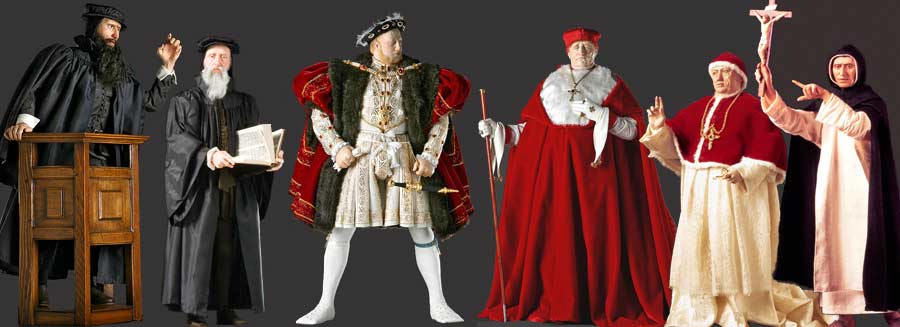
http://www.galleryhistoricalfigures.com/primarygroup.php?GroupName=Renaissance%20and%20Reformation
What is Premodernism, Modernism and Postmodernism? Are definitions possible?
In this illustration, we see King Henry 8th surrounded by both Catholic and Protestant personalities of the Reformation (The Church in Rome suffered a 'split' as 'protestors' like the former Catholic priest Martin Luther, broke away to form or 'reform' new Christian communities called Protestants (there were many different types of Christian denominations from that time onwards).
However, what is notable about the Era of Premodernism - the Pharaohs in Egypt, the Emperors in Rome, or the Incas in the Americas and the Emperor of Japan was one shared common factor.
The Leader of the Government and the Leader of the Religious Faith were generally the two most powerful people in any society.
Difficult to understand today but Cardinal Wolsey was Prime Minister in King Henry's Council of Advisors (government). Cardinal Richelieu held a similar position under King Louis the Fourteenth in France.
It seemed natural that the Pope and Senior Clerics in Christian Countries would hold senior positions in the government. When Oliver Cromwell led a Protestant Revolution in England, he replaced Catholic power with Protestant power. But religion still held huge power until the Age of the Enlightenment.
The Age of the Enlightenment. emphasizing reason, individualism, skepticism, and science. Enlightenment thinking helped give rise to deism, which is the belief that God exists, but does not interact supernaturally with the universe.
The modern period in Western philosophy began, perhaps, with the Enlightenment, that period in which people began questioning and seeking in new ways in a number of fields. In the 1600s, physician William Harvey began opening up cadavers to see what was inside--and the reality was very different from what Aristotle and his philosophy of human science had said was inside people. Similar revolutions occurred elsewhere as Galileo and Copernicus developed proofs that that the sun did not revolve around the earth, Reformation-minded Protestant and Catholic theologians changed the map of Christian practice and belief, and ancient and modern writings became more accessible to everyone through the invention of mass-produced books.
The Enlightenment brought to philosophy a renewed interest in the philosophies of other parts of the world and in the Greek philosophers who came before Plato and Aristotle. Philosophers began to ask once again, as had many of the early Greeks, such questions as "What is God?", "How do I know that I exist?", and "What is reality?" In scholasticism, these questions all had been answerable by some form of religious or Platonic doctrine. Gradually philosophers began to ask any question once again.
Much of Western philosophy began to concern itself in the West with issues the Greeks had discussed and Hindu philosophers had analyzed for a thousand years. Rene Descartes, 1596-1650, suggested that all philosophy starts, not with scripture, God, or old philosophies, but rather with this principle: "I think, therefore I am." There were some people who felt Descartes should be put to death for such a radical belief..
Premodernism (Ancient times up to 1650's)
Epistemology. The primary epistemology of the
premodern period was based upon revealed knowledge (Truth was revealed by God or Gods in Holy Books or by Oral Custom and Tradition). These were considered authoritative sources.
In premodern times it was believed that Ultimate Truth could be known and the
way to this knowledge is through direct revelation. This direct revelation was
generally assumed to come from God or a god.
Sources of Authority. The church, being the
holders and interpreters of revealed knowledge, were the primary authority
source in premodern time. Additionally,
Modernism (1650-1950's) If we begin with the Age
of Englightenment.
However, in Literature the dates are more commonly
seen as 1900 to 1945. Initial optimism about the potential of education,
science and technology (knowledge) to improve the lives of millions of people
are dashed by the slaughter of the First World War. So although TS Eliot and
Yeats are considered to be Modernists we can see in “The Waste Land” and “The
Second Coming” a very pessimistic view
of people and society.
However, Eliot and Yeats were both concerned with spiritual questions either Christian (Eliot) or more mystical (Yeats).
Epistemology. Two new approaches to knowing became
dominant in the modern period. The first was empiricism (knowing through the
senses) which gradually evolved into scientific empiricism or modern science
with the development of modernist methodology. The second epistemological
approach of this period was reason or logic. Often, science and reason were
collaboratively or in conjunction with each other.
Sources of Authority. As the shift in power moved
away from the church, politics (governments, kings, etc.) and universities
(scholars, professors) took over as the primary sources of authority.
Oftentimes, a religious perspective was integrated into these modern authority
sources, but the church no longer enjoyed the privileged power position.
Postmodernism (1950's to current times)
Epistemology. Postmodenism brought with it a quesioning of
the previous approaches to knowing. Instead of relying on one approach to
knowing, they advocate for an epistemological pluralism which utilizes multiple
ways of knowing. This can include the premodern ways (revelation) and modern
ways (science & reason), along with many other ways of knowing such as
intuition, relational, and spiritual.
Sources of Authority. Postmodern approaches seek
to deconstruct previous authority sources and power. Because power is
distrusted, they attempt to set up a less hierarchial approach in which
authority sources are more diffuse.
Grateful acknowledgement to this website for the source material.

No comments:
Post a Comment
Note: only a member of this blog may post a comment.